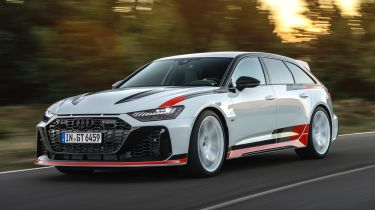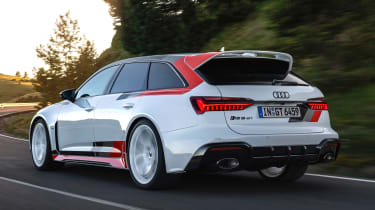New limited-run Audi RS 6 GT is the ultimate RS 6 and, at £176k, it should be
The new Audi RS 6 GT will be limited to 660 units worldwide, 60 of which will come to the UK
Audi’s RS 6 high performance estate is about to go through quite a change as it adopts plug-in and full-EV powertrains for the next generation, but not without a final hurrah for the current model. This is the Audi RS 6 GT, a limited-run ultimate iteration of the current V8-powered Audi RS 6 that’s full to the brim with bespoke design elements and has a tweaked chassis. Only 660 units will be built, and 60 of those will be coming to the UK with a price tag of £176,975.
Before you get too excited, it’s worth breaking the news that the GT doesn’t have any more power than the current RS 6 Performance, with a total of 621bhp and 850Nm of torque generated from its twin-turbocharged 4.0-litre V8. This is still connected to an eight-speed automatic transmission and RS-specific quattro all-wheel drive system, but Audi Sport has tweaked the Sport quattro Differential on the rear axle to give it even more aggressive characteristics when the car is in its sportier drive modes.
Still, performance has improved marginally over the Performance, with another tenth of a second knocked off the existing Performance model’s 0-62mph time - now claimed at just 3.3 seconds. Audi’s colossal 420mm carbon ceramic front brakes with ten-piston calipers are also fitted as standard.
It’s the suspension which has been most significantly overhauled, with a new coilover setup that pairs bespoke, manually adjustable dampers to lowered coil springs. Audi has also tweaked the anti-roll bars at both ends, which are 30 per cent stiffer on the front axle and 80 per cent stiffer on the rear. As standard, the GT sits 10mm lower than a standard RS 6, and should deliver a more direct and natural road feel. If customers wish, they can still opt for the standard air-springs or ‘DRC’ hydraulically crosslinked suspension options, too.
Exterior design
Potentially more obvious are Audi’s changes to the RS 6’s already rather auspicious design. The bonnet and front wings are both bespoke and made of carbon fibre, the latter featuring an RS 3-style vent that Audi says aids with brake cooling. The front bumper is also new, and is matched to the new rear bumper fitted with an even more aggressive diffuser insert again made of, you guessed it, carbon fibre.
Audi has also fitted a large rear wing, and this is also notably the first time that an RS 6 model hasn’t featured roof bars. These aesthetic updates are then paired to a unique 22-inch wheel design that features a modern interpretation of the six-spoke design that was used across Audi’s high performance models from the nineties.
Audi will offer the RS 6 with livery packages that reference the brand’s classic racing colours. There are actually three different liveries available, including the Arkana White setup seen here, plus slightly more subtle options based on Nardo Grey or Mythos black base colours. In both darker liveries, the wheel finish is swapped to black – in either gloss or matte finishes. As well as these, customers can opt for one of five basic colours in a spectrum from black to white with a few greys in between, as well as Madeira brown.
RS 6 GT interior
Audi’s also been at work on the interior, increasing the use of Dinamica material across the doors, dash and seats. As standard, all GT models feature a new set of carbon fibre-backed bucket seats that, unlike the RS 4 Competition, will be offered on UK models. These are finished in a combination of black leather and Dynamica, with red and gold stitching, again referencing Audi’s classic racing colours. The dash and door decor trims are also finished in Dinamica as standard, although buyers can opt for an unlacquered carbon fibre finish if they prefer.
All of these unique elements are applied at Audi Sport specialised plant after rolling off the usual production line, which is responsible for the R8 and e-tron GT models. While this does celebrate the end of the RS 6 line as we know it, the moniker will soon be put to use in an all-electric RS 6 e-tron that’s already well into its development phase.
A combustion-powered equivalent will come along in the form of a new RS 7 Avant due in late 2025 or early 2026, but like the smaller RS 5 Avant we recently spotted, the RS 7 will feature a plug-in hybrid powertrain. This extreme high performance plug-in hybrid estate class is going to get very crowded, with BMW’s new M5 and a new generation AMG E-Class also both on their way.
Click here for our list of the best performance cars to buy...
Find a car with the experts








